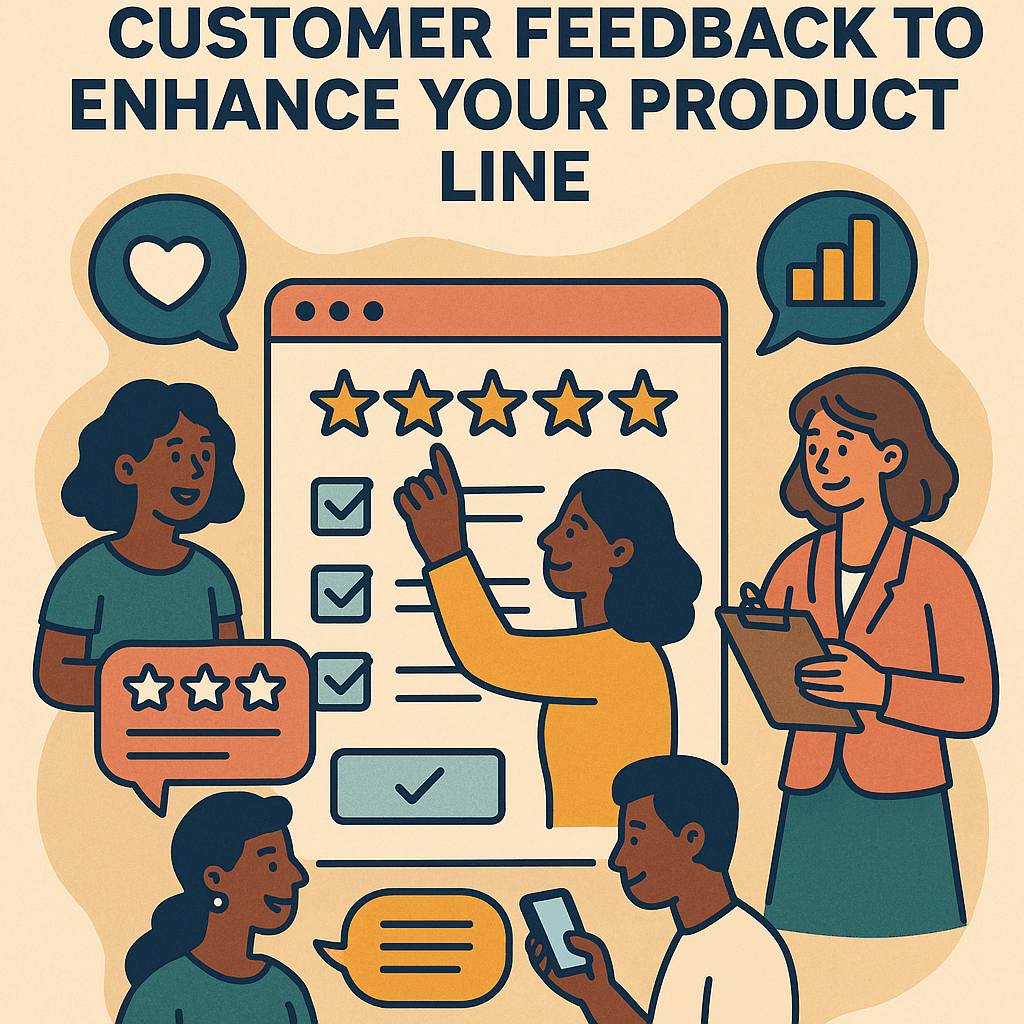How to Utilize Customer Feedback to Enhance Your Product Line

Why Customer Feedback Is Your Secret Weapon
As a boutique owner, you’re constantly trying to predict what your customers will love next season. But what if I told you the answer is already right in front of you? Your customers are literally telling you what they want to buy—you just need to listen!
Customer feedback isn’t just about handling complaints. It’s a goldmine of insights that can transform your boutique’s inventory strategy, help you discover emerging trends before your competitors, and ultimately boost your bottom line.
According to recent retail studies, businesses that effectively implement customer feedback see up to 25% higher customer retention rates and a 15% increase in sales compared to those that don’t. That’s not just impressive—it’s game-changing for small boutiques.
Let’s dive into how you can harness this powerful tool to enhance your product line and keep your boutique thriving.
Types of Customer Feedback You Should Be Collecting
Before we get into implementation strategies, let’s talk about the different types of feedback you should be gathering:
Direct Feedback
This is feedback customers intentionally provide:
- In-store conversations
- Email surveys
- Social media comments
- Product reviews
- Comment cards
- Focus groups
Indirect Feedback
This feedback is observed rather than explicitly stated:
- Sales data and purchasing patterns
- Website analytics (product page views, abandoned carts)
- Social media engagement (which posts get the most attention)
- Return rates and reasons
- Time spent browsing certain collections
- Heatmaps showing where customers focus on your website
Solicited vs. Unsolicited Feedback
Solicited feedback is what you specifically ask for—like sending out a survey about your new summer fashion collection.
Unsolicited feedback comes organically—like a customer spontaneously commenting about a product feature they love or hate.
Both types are valuable, but unsolicited feedback often reveals raw, unfiltered opinions that customers might not share when formally asked.
How to Collect Quality Customer Feedback
Now that you know what types of feedback to look for, let’s talk about how to collect it effectively:
1. Create Multiple Feedback Channels
Not all customers communicate the same way. Some prefer face-to-face conversations, while others feel more comfortable sharing thoughts online.
Set up various channels:
- In-store comment cards
- Post-purchase email surveys (keep them short!)
- Website feedback forms
- Social media polls and questions
- QR codes on packaging that link to feedback forms
- Quarterly focus groups with loyal customers
2. Ask the Right Questions
The quality of feedback depends heavily on the questions you ask. Avoid yes/no questions and instead ask:
- “What would make this maxi dress even better for you?”
- “If you could change one thing about our accessories collection, what would it be?”
- “Which items do you wish we carried more of?”
- “What trends are you excited about that you don’t see in our store?”
3. Incentivize Participation
People are more likely to provide feedback when there’s something in it for them:
- Offer a small discount on their next purchase
- Enter respondents into a monthly giveaway
- Provide early access to new arrivals
- Create a points system where feedback earns loyalty rewards
4. Make It Easy and Quick
Customer time is valuable—respect it by:
- Keeping surveys under 5 minutes
- Using rating scales when possible
- Including progress bars on digital surveys
- Allowing partial completion that can be saved and finished later
5. Create a Feedback-Friendly Culture
Train your staff to:
- Casually ask for opinions during checkout
- Note down comments customers make while shopping
- Thank customers sincerely for their input
- Follow up on previous feedback when regular customers return
Analyzing Customer Feedback: Finding the Gold
Collecting feedback is only half the battle. The real value comes from analyzing it effectively:
Categorize Feedback by Theme
Sort feedback into clear categories:
- Product quality concerns
- Style preferences
- Price point feedback
- Size and fit issues
- Color and pattern preferences
- Seasonal requests
- Material preferences
- Service-related comments
Look for Patterns, Not Just Individual Comments
One customer requesting neon green rompers might be an outlier. But if 15 customers mention wanting more rompers in bold colors, that’s a trend worth noting.
Track feedback over time to identify:
- Recurring requests
- Seasonal patterns
- Demographic-specific preferences
- Emerging trend indicators
Cross-Reference with Sales Data
Customer feedback becomes even more powerful when paired with your sales data:
- Are items customers praise also selling well?
- Are there highly-requested items that you don’t currently stock?
- Do returns correlate with specific feedback themes?
- Is there a disconnect between what customers say they want and what they actually buy?
As noted in our blog about maximizing profit margins, understanding these patterns can significantly impact your bottom line.
Prioritize Actionable Insights
Not all feedback can (or should) be acted upon immediately. Prioritize insights based on:
- Frequency of mention
- Potential sales impact
- Implementation cost and difficulty
- Alignment with your boutique’s brand identity
- Seasonality and timeliness
Implementing Feedback: Turning Insights into Inventory
Now for the exciting part—taking what you’ve learned and using it to enhance your product offerings:
1. Test Before Fully Committing
Before ordering 100 pieces of that new style customers requested:
- Start with a small test order
- Feature new items prominently and monitor response
- Create a “based on your feedback” marketing campaign
- Get real-time feedback as customers interact with the test items
2. Create Feedback Loops
The feedback process should be continuous:
- Follow up with customers who provided specific suggestions
- “You asked, we listened” email campaigns when you implement changes
- Before/after comparisons showing how you’ve evolved
- Regular check-ins about previously implemented changes
3. Balance Feedback with Expertise
While customer feedback is invaluable, it needs to be balanced with:
- Your fashion expertise and industry knowledge
- Upcoming trends you’ve identified at wholesale markets
- Your boutique’s unique aesthetic and positioning
- Practical considerations like profit margins and minimum orders
Remember that sometimes you need to lead customers to new trends they don’t yet know they’ll love—like our trending items collection that often features emerging styles.
4. Update Your Buying Strategy
Use feedback to refine your wholesale buying approach:
- Adjust size ratios based on customer demand
- Identify gaps in your current offerings
- Negotiate with vendors for styles similar to requested items
- Reconsider price points based on customer value perception
- Expand or contract categories based on interest
For example, if customers consistently request more options in your plus size collection, that’s a clear signal to invest more in that category.
Case Study: Feedback Success Stories
Let’s look at how real boutiques have used customer feedback to transform their businesses:
Boutique A: The Power of Listening
A small coastal boutique noticed consistent feedback about their dresses being slightly too short for their demographic (women 40+). After adjusting their inventory to include more midi-length options from the midi dresses collection, they saw a 30% increase in dress sales within one season.
Boutique B: Unexpected Opportunity
Through customer surveys, a midwest boutique discovered many customers were purchasing their cardigans and kimonos specifically for office wear. This insight led them to create an “Office Style” section featuring appropriate lengths and styles for work environments, opening up an entirely new customer segment.
Boutique C: Avoiding a Costly Mistake
After pre-ordering a large shipment of a new jumpsuit style, one boutique owner created a social media poll showing the incoming product. The lukewarm response allowed her to adjust her order before it shipped, saving thousands in potential dead stock.
Common Feedback Implementation Challenges
Implementing customer feedback isn’t always smooth sailing. Here are some challenges you might face and how to overcome them:
Challenge 1: Contradictory Feedback
When different customer segments want opposing things, try:
- Segmenting your inventory to serve different customer groups
- Creating limited collections that rotate focus between different preferences
- Using clear marketing to help customers find “their” section of your boutique
- Offering special orders for loyal customers with specific requests
Challenge 2: Feedback That Doesn't Align With Your Brand
When customers request items that don’t fit your boutique’s identity:
- Explain your brand positioning gently
- Suggest alternatives that serve the same need while fitting your aesthetic
- Consider a small capsule collection that bridges the gap
- Refer customers to other local businesses that might better serve that specific need
Challenge 3: Implementing Feedback Takes Time
When changes can’t happen immediately:
- Communicate timelines transparently
- Create “coming soon” promotions based on feedback
- Offer pre-orders for highly requested items
- Show behind-the-scenes looks at how you’re working on their suggestions
Measuring the Impact of Feedback Implementation
How do you know if your feedback-based changes are working? Track these metrics:
- Sales lift in adjusted categories
- Reduction in return rates
- Increased customer satisfaction scores
- Higher conversion rates on previously problematic products
- Customer retention statistics
- Social media engagement on new or modified products
- Sell-through rates on feedback-influenced inventory
Creating a Continuous Feedback Culture
The most successful boutiques make feedback an ongoing part of their business strategy:
Schedule Regular Feedback Activities
- Quarterly customer surveys
- Monthly social media polls
- Seasonal focus groups
- Weekly team meetings to discuss customer comments
- Bi-annual in-depth inventory analysis based on feedback
Make Feedback Collection Visible
- Display “We value your opinion” signage in-store
- Include feedback links on receipts
- Create social media content showcasing how you’ve used previous feedback
- Feature customers who provided valuable insights (with permission)
As our article on navigating the post-pandemic fashion landscape points out, adaptability based on real customer insights is more important than ever in today’s retail environment.
Technology Tools That Help
Leverage technology to streamline your feedback process:
- Customer feedback software like Typeform or SurveyMonkey
- Social listening tools to monitor brand mentions
- POS systems that can track purchase patterns
- Email marketing platforms with survey capabilities
- Analytics tools for website behavior tracking
- Review management systems
Final Thoughts: Feedback as Your Competitive Edge
In today’s competitive boutique landscape, the businesses that thrive aren’t just those with the trendiest merchandise—they’re the ones that listen most carefully to their customers.
By creating a systematic approach to collecting, analyzing, and implementing customer feedback, you’re not just improving your product selection. You’re building deeper customer relationships, creating brand advocates, and positioning your boutique as one that truly cares about meeting customer needs.
Remember that feedback implementation isn’t a one-time project but an ongoing practice that should become part of your boutique’s DNA. The insights you gather today will help shape your buying decisions for seasons to come.
Ready to refresh your inventory based on what your customers really want? Browse our contemporary collection for sophisticated styles or check out our trending items that customers are already loving.
Have questions about how to select wholesale clothing based on your customer feedback? Our team is here to help you translate customer insights into smart inventory decisions. Contact us today to discuss your specific needs and discover how our wholesale collections can help you respond to what your customers want most.

